Did you check your social media channels today? I am guessing you did. How many product/service commercials did you see? Did any of them capture your attention? Have you clicked through to learn more? Did you make a purchase? Most of us don’t give much thought to what motivates us to act on a call to action, yet this is a fact: Your response to each ad is determined by your level of involvement with the brand and the content delivered using engagement marketing.
This means that the likelihood of you to even notice an ad as you scroll through your social feeds depends on whether the ad is relevant to you and the interactions you’ve had with the business before viewing the ad, timing, placement, and many other factors. In short, your level of involvement with the brand, as well as your ability to cultivate and sustain consistent levels of engagement over time, can influence your next action. Do you continue to scroll or click through? In the following article, I will define engagement marketing, explain why it is crucial to a brand’s long-term success, and provide ideas for effective engagement marketing.
Key Takeaways
- Engagement marketing moves beyond traditional advertising by fostering meaningful two-way interactions. Brands that create personalized, interactive experiences are more likely to build lasting relationships with their customers, turning passive viewers into active participants.
- Successful engagement marketing starts with a profound understanding of your audience. Use CRM systems and data analytics to gather insights into customer preferences, behaviors, and pain points. This knowledge allows you to tailor your marketing strategies and content to meet their specific needs effectively.
- Incorporating interactive elements like quizzes, polls, and surveys can significantly boost engagement. Additionally, leveraging marketing automation tools and AI, such as chatbots, can enhance customer support and personalize the customer journey, making interactions seamless and timely.
- Setting clear KPIs and continuously measuring performance is vital. Track metrics such as engagement rates, conversion rates, and customer satisfaction scores to understand what works. Use these insights to refine your strategies, experiment with new ideas, and scale successful campaigns for greater impact.
What is Engagement Marketing?

Engagement marketing, often known as experiential marketing, extends beyond the typical push for products and services. It’s all about having meaningful connections and developing relationships with your audience. Unlike traditional marketing, which focuses on broadcasting messages, engagement marketing prioritizes a two-way conversation in which customers feel valued and involved.
Engagement marketing is all about initiating a two-way discussion with your customers. Instead of communicating with customers through generic commercials and email campaigns, you make the experience feel more individualized, distinctive, and fascinating.
The secret to effective engagement marketing is to meet your clients where they are and create experiences that they cannot help but participate in. You wish to start a social media. They can join a campaign, take part in a vote, or receive a push notification on an amazing deal at the appropriate time. It’s a marketing strategy that complements personalization, thus marketing automation and clever AI are frequently used in your efforts.
Engagement marketing exists in practically every marketing platform, including content marketing, email marketing, social media, and community building. Engagement marketing may be integrated into every stage of the customer journey, from branded events that build awareness to personalized recommendations at checkout.
How Does Engagement Marketing Work?
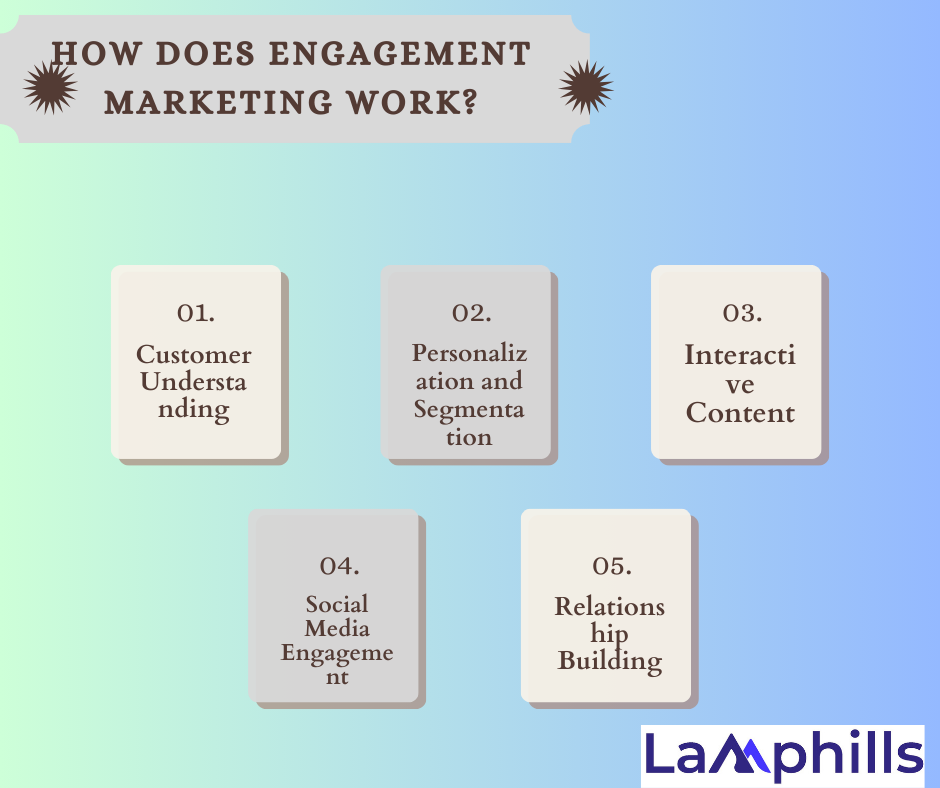
Engagement marketing involves various strategies and techniques to actively involve customers in meaningful experiences. Here’s how it typically works:
#1. Customer Understanding
To effectively engage customers, firms must first define their target audience. This includes collecting demographic information, evaluating customer behavior, and determining preferences or pain areas. client relationship management (CRM) systems and data analytics are critical in identifying client demands and providing personalized experiences.
#2: Personalization and Segmentation
Engagement marketing is based on providing individualized information and experiences. Businesses divide their consumer base based on demographics, tastes, or behavior to generate targeted marketing strategies. Engagement marketing uses personalization tactics such as personalized emails, dynamic website content, and targeted social media adverts.
#3. Interactive Content
By following this checklist below, you can create interactive content that not only engages your audience but also drives valuable insights and conversions. Whether you’re new to interactive content or looking to refine your strategy, these steps will help you create impactful and memorable experiences for your customers.
Quizzes, polls, surveys, and interactive movies are common forms of interactive content used to engage clients. These interactive experiences draw attention, stimulate involvement, and allow customers to actively engage with the business.
#4: Social Media Engagement
Social media platforms are extremely effective instruments for engagement marketing. Businesses utilize social media to spark conversations, respond to customer feedback, publish user-generated content, and launch interactive campaigns. These initiatives stimulate client participation and foster a sense of community surrounding the business.
#5: Relationship Building
Engagement marketing seeks to establish long-term relationships with clients. Businesses focus on continual contact, actively listen to consumer input, and offer individualized service. Businesses build loyal and pleased clients by developing relationships and meeting their requirements.
Types of Engagement Marketing
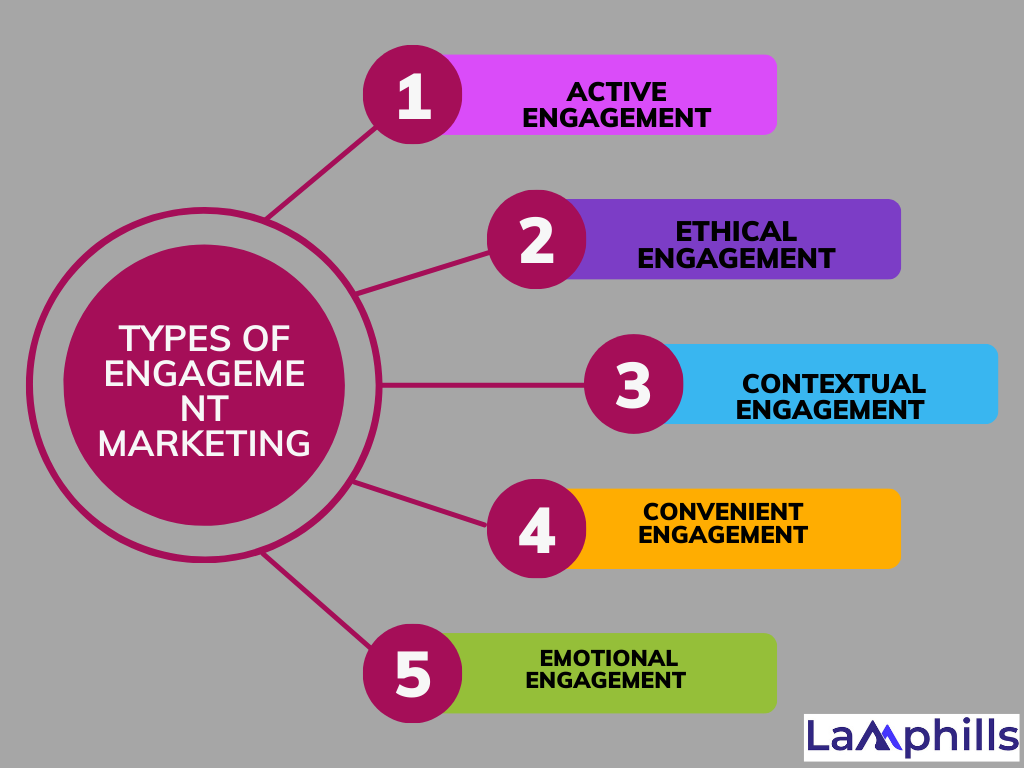
There are different strategies you can use to engage potential customers, which is one thing that makes engagement marketing so great. Because it’s so versatile, it allows businesses to adapt the strategy to fit their brand identity and what their audience responds to. When boiled down to the core function of your engagement, this strategy can fit one or more of seven different purposes from the following list:
#1. Active Engagement
This essentially encourages consumers to actively participate in one or more of your channels. Consider asking customers to submit feedback when posing a question about your brand or to share a product sample with a friend. To make this form of connection succeed, you must be friendly while still clearly communicating what you want your clients to accomplish.
#2. Ethical Engagement
Consumers place a high value on a brand’s ethics; 73% of Millennials are willing to pay more for firms that adopt ethical and sustainable business methods. Ethical engagement entails proving your dedication to your customers, staff, and community. Hosting fundraisers, promoting a positive work-life balance for your employees, and focusing on moral missions can all work well and make customers want to be involved with your brand.
#3. Contextual Engagement
This is a sort of engagement that marketers may monitor using analytics to determine who the user is and what their behavioral motives are. This knowledge is actionable, and it should be leveraged to develop content that appeals to this target demographic, leveraging the data available as important context. This may include sending a push notification to a consumer encouraging them to buy an item that compliments their most recent purchase.
#4: Convenient Engagement
Simply simply, customers buy and interact more when it is convenient for them. Convenient engagement focuses on driving results through simple, integrated experiences that are consistent with a customer’s purchasing history and shopping habits. Amazon’s Dash buttons include a prime example; it was designed to position Amazon as the central player in essential shopping by creating a seamless, streamlined shopping experience: All customers need to do is hit the Dash button when they want to purchase again.
#5. Emotional Engagement
Emotions have a lot of influence in marketing. They have a strong, unforgettable impact on your target group and can be a significant motivator. Emotional engagement, then, is all about reinforcing the client’s emotional ties to a brand and what it does or offers. A business that pledges to donate a pair of shoes or socks for each pair purchased by a consumer is one example.
How to Plan, Implement, and Optimize Your Engagement Marketing Strategy
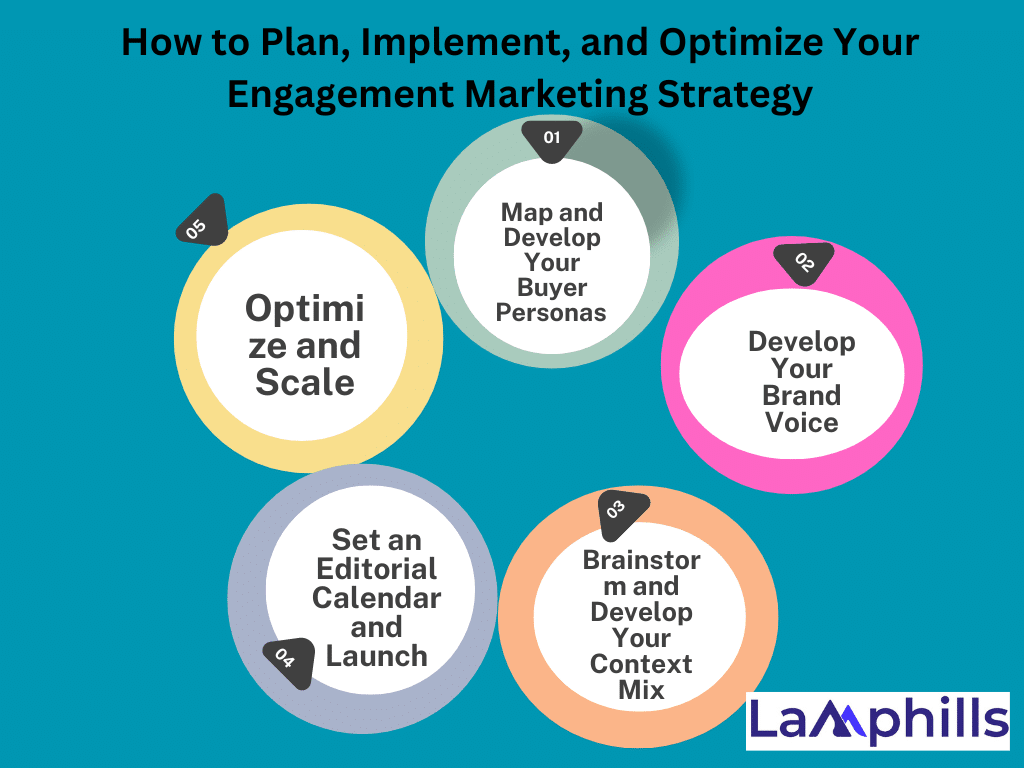
Engagement marketing is a multi-channel strategy that needs preparation, execution, optimization, and maintenance. This means rolling out a program can be a lot of work, but you will get what you put into it. I recall the early stages of my career when I worked for a small computer business. Back then, marketing was like shouting into the void. We ran ads, sent emails, and hoped for the best. It wasn’t until we discovered engagement marketing that things changed.
Suddenly, our customers became more than passive recipients of our communications; they were active participants in our brand story. The transformation was remarkable. Our email open rates surged, social media followers doubled, and, most significantly, our sales statistics began to climb. This experience taught me the incredible power of engagement marketing, and today, I’m excited to share with you some innovative approaches to boost customer interaction.
#1: Map and Develop Your Buyer Personas
Before you start producing new campaigns or content, determine what kind of information your current and future buyers need. Your buyer personas will help you define:
- Your audience
- Their challenges
- Questions they have
- Their needs
- The content they like to consume
While their buying stages tell you what each piece of content you create for them should accomplish.
#2: Develop Your Brand Voice
It’s critical to provide a consistent experience across all channels, which requires you to define your brand’s voice. Whether you’re writing for your blog, website, or social media, the tone you choose will define your brand’s identity.
Remember that while you might choose to use a more lighthearted tone on Twitter and a more professional tone in a whitepaper, consistency is essential.
#3: Brainstorm and Develop Your Context Mix
Planning and developing new marketing engagement strategies and methods entails more than simply mapping and data; it also requires the creation of original content. Consider what type of material will best serve your objectives. Content marketing comes in many forms, and the form you choose depends on many factors. This includes you:
- Audience’s preferences
- Industry’s standards
- Bandwidth and budget
#4: Set an Editorial Calendar and Launch
An editorial calendar is more than just a tool for tracking, coordinating, and sharing impending material. It’s also a strategic tool for your team to implement integrated programs that incorporate your content.
Using an editorial schedule guarantees that you release your material at the greatest available time. It also helps your entire team stay on track with release dates.
#5: Optimize and Scale
Your promotion strategy will be determined by your target demographic and needs, but the most effective method is comprehensive. Don’t start scaling and adding new channels until you have a solid measuring plan in place.
To do this, you’ll need to:
- Define your content goals
- Decide how you will measure results
- Align your key stakeholders
Lastly, I recommend covering your bases by measuring early-stage metrics and then tying them back to pipeline and revenue.
Tips for Effective Engagement Marketing
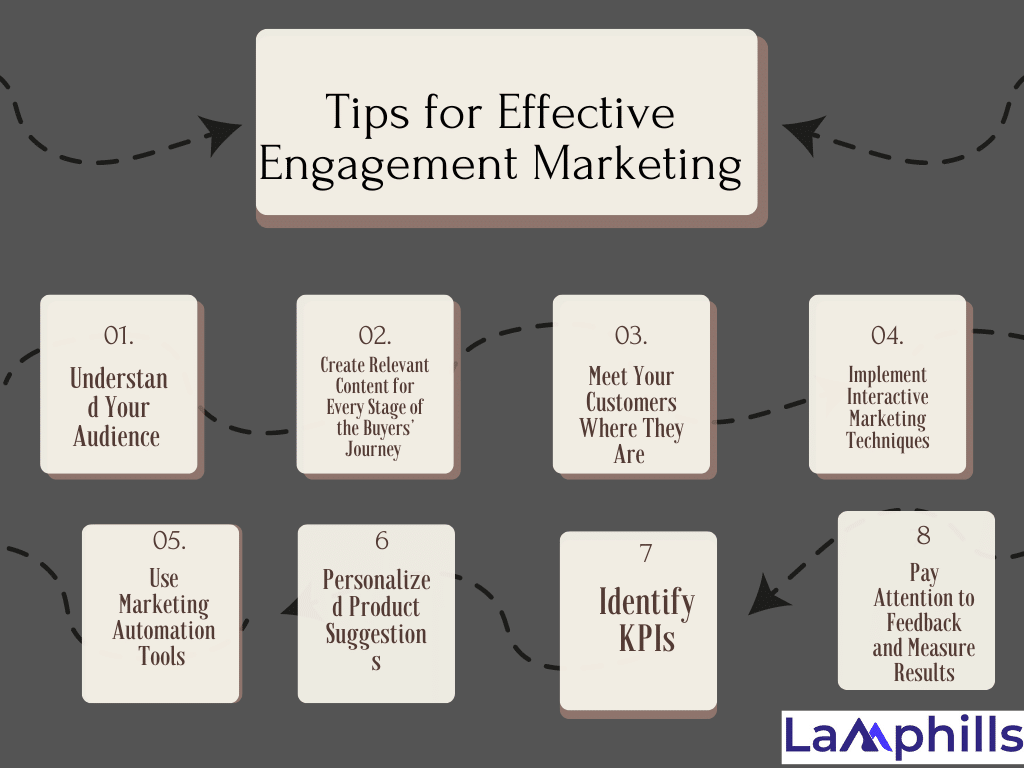
Now that you’ve got your customer engagement strategy all planned out, it’s time to add a few final touches to make it a success. Here are a few extra tips:
#1. Understand Your Audience
Maintaining engagement means providing opportunities to interact with your brand at every step along the customer journey – so it’s essential to first understand your customers’ buying behaviors and map out their journey. How do they research products and services? What channels do they use most? How long is the buying cycle? Who’s involved? Seeing the journey through the customer’s eyes is the first step to understanding how to engage them effectively.
#2. Create Relevant Content for Every Stage of the Buyers’ Journey
Now that you know how they go about buying products and services, make sure you give them opportunities to interact with you at every touchpoint. Design content that supports their needs at every stage in the funnel, from their original expression of interest through their decision to purchase and after product implementation.
#3. Meet Your Customers Where They Are
Social media platforms provide a dynamic environment for interaction marketing. Interact with your audience regularly by responding to comments, asking questions, and starting conversations around your material. Share user-generated material, hold contests, and write engaging posts to promote likes, shares, and comments. By expressing genuine interest in your audience’s opinions and experiences, you may establish a feeling of community and strengthen relationships.
Furthermore, to meet your clients where they are, ensure that you disseminate content across all of the mediums they use. For example, if you cater to a younger audience, try new channels like TikTok, even if you’ve never used them before. If you find more traditional channels are what your customers prefer, don’t be afraid to resurrect them. Direct mail is making a comeback, after all!
#4. Implement Interactive Marketing Techniques
Interactive content stands out in a congested digital market and encourages active engagement from your viewers. Quizzes, polls, surveys, and interactive infographics can all help to pique people’s interest and participation. Interactive tactics not only hold your audience’s interest, but they also reveal useful information about their preferences and actions. This data can help you plan your future content production and engagement initiatives, ensuring that you constantly give what your audience wants.
#5. Use Marketing Automation Tools
Artificial intelligence (AI) and chatbots have transformed customer service. They give immediate assistance, answer questions, and walk consumers through their trip. Chatbots, such as those employed by Sephora, provide individualized recommendations and are available 24/7, increasing client pleasure and engagement.
Automation is critical for effectively executing marketing initiatives and programs in today’s fast-paced business environment, as well as the abundance of available data. However, with so many tools and technologies available, choosing and applying the appropriate ones can be difficult. Consider outsourcing this effort to a reputable company with experience with marketing automation tools.
#6. Personalized Product Suggestions
Personalization is essential in making clients feel special. Businesses can use data to create bespoke experiences that are relevant to individual tastes. I recall a campaign in which we tailored email content based on user behavior. What was the result? A 35% increase in click-through rate. Netflix’s recommendation system is an excellent example of personalization, as it suggests series and movies based on viewing history.
Customers do not want to be bombarded with irrelevant new product recommendations or generic promotions that they will never be interested in. Instead, use data and automation tools to provide individualized product recommendations to your clients.
There are lots of ways to do this. Use the data you hold on your customers’ browsing and buying history to create tailored suggestions — like Netflix does with your personalized recommendations. Another option is to introduce an interactive product quiz on your website to help your customers find their ideal product.
#7. Identify KPIs
Don’t leave your engagement marketing success up to chance. Set specific KPIs from the start and thoroughly track them. Understanding how your campaigns and programs are performing can help you optimize and refine them. Time on page and bounce rates, social comments and shares, open and clickthrough rates, and conversions are all crucial engagement marketing KPIs to keep track of.
#8. Pay Attention to Feedback and Measure Results
Tracking the success of your engagement marketing campaigns is critical. Customer happiness, social media engagement, and conversion rates are all important KPIs. Analyzing these metrics helps you learn what works and what needs to be improved. Adjusting your tactics based on facts guarantees ongoing progress and success.
Relevant analysis and insights must be used as guides throughout the process. Remember that the approach will only be successful if it is effective in satisfying customers. So, pay heed to what they say.
An excellent concept is to establish engagement in such a way that the audience provides input. You can accomplish this using social media posts, opinion polls, and a range of other tools. For example, Instagram’s Stories provides a question area, which you can use to listen to what the followers have to say.
In addition to paying attention to the public reaction, it is important to base your analysis on data. Collecting and evaluating information about the performance of your content and approaches is the only way to determine if the strategy can improve, in addition to figuring out how to do it.
Benefits of Engagement Marketing
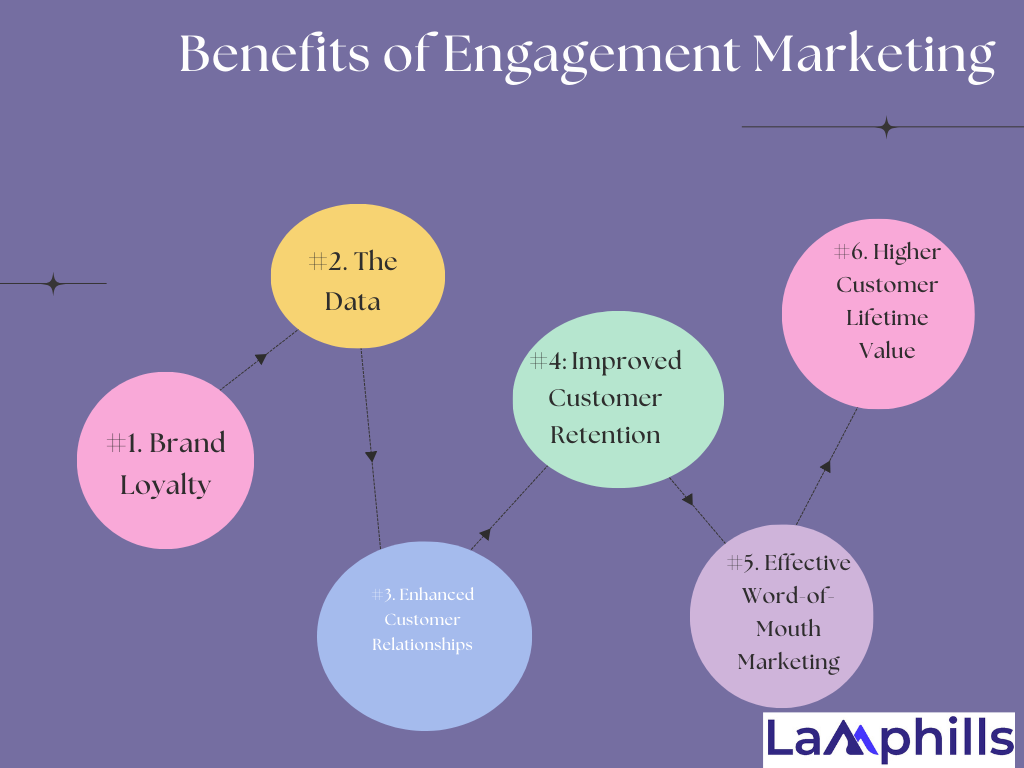
Even if it does not produce the fastest results possible, engagement marketing is incredibly effective since it generates a dynamic branded experience that your audience will remember for a long time. The advantages of interaction marketing are numerous. It increases brand loyalty, stimulates word-of-mouth marketing, and improves customer happiness. According to a HubSpot survey, businesses that prioritize customer involvement beat their competition by 202%.
#1. Brand Loyalty
Engagement marketing aims to draw users into your brand. Consider a business that you are enthusiastic about and would advocate for. How involved do you feel with this brand?
I know I’d advocate for my kickboxing studio, for example; they’ve utilized me in some of their marketing initiatives, and I like how hard they work to prepare students for competitions. I’m more than simply a consumer; I’ve been associated with the brand.
I’m also a new client of Stasher (the silicone bags mentioned above) and have suggested them to several friends and family. Every time I order a new set, they send me a free bag to give away (causing active involvement). I adore their sustainability. and their mission (which triggers emotional engagement), and I’m now a loyal customer and brand advocate.
#2. The Data
Research shows that creating an experience that involves your clients in your brand’s core identity will pay off substantially. Better engaged customers will purchase more and they’ll purchase more often. They’re more loyal and they’ll be more likely to share the great news of your brand with those in their network. One study found that as many as 74% of customers are more likely to buy a product that was being promoted with branded engagement marketing than other types of marketing.
#3. Enhanced Customer Relationships
Engagement marketing enables organizations to interact with their customers on a deeper level. Businesses that actively engage customers in interactive experiences such as surveys, contests, or social media discussions can gain valuable insights, learn client preferences, and modify their services accordingly. This individualized approach strengthens client relationships and promotes loyalty and advocacy.
#4: Improved Customer Retention
Businesses that focus on interaction can enhance client retention rates. When customers feel actively involved and valued, they are more inclined to stick with a brand. Personalized emails, special deals, and loyalty programs are examples of engagement marketing methods that generate a sense of exclusivity and appreciation for customers, motivating them to stick with the business.
#5. Effective Word-of-Mouth Marketing
Engagement marketing encourages customers to become brand ambassadors and share their positive experiences with others. This is because customers who actively engage with a company are more likely to promote it to their friends, family, and social networks. Word-of-mouth marketing has a significant impact on brand reputation, credibility, and the acquisition of new customers.
#6. Higher Customer Lifetime Value
Customers that are engaged are more valuable to a company in the long run. Businesses may boost customer loyalty and encourage repeat purchases by cultivating continuing relationships and providing tailored experiences. Engaged clients are also more inclined to investigate additional products or services offered by the brand, resulting in increased revenue and profitability.
Engagement Marketing Mistakes Most Brands Are Making
Engagement marketing can work wonders for your brand, but only if you’re executing your campaigns well. To ensure a great campaign, keep these important principles of engagement marketing in mind:
- A relentless focus on building trust
- Embracing strong two-way communication
- An exchange of value
- A relationship focus
- A long-term view
Now, here are the three most common mistakes to watch out for to keep your campaigns on track and your customers engaged.
#1. The Experience Isn’t Personalized for Your Audience
When creating engagement marketing campaigns, it’s so crucial to think about what your audience will respond to most. There are several different types of “experiences” that you can offer customers with engagement marketing, including:
- Classes and workshops
- One-on-one events
- Product showcases
- Pop-up experiences
- Direct mail, including personalized, handwritten notes
A local barre studio, for example, knows that most of their customers love healthy, green eating, so they regularly host pop-up events where their receptionist (who owns her own nutrition business) shares classes and recipes with the studio:
It’s a win-win for both companies and the studio members, and it works well because it’s tailored to the specific audience, which increases the propensity for them to engage with the brand.
A gym that was focusing on #gainz likely wouldn’t want low-calorie, vegan recipes; their members are more likely to be interested in learning about finding the right balance of carbs and protein to increase muscle mass quickly.
#2. You’re Not Thinking Outside the Box
Thinking outside the box is one of the most enjoyable aspects of engagement marketing! Finding innovative ways to have meaningful interactions with your audience will help you stand out, leaving lots of potential for creativity.
If I were selling dog toys, the typical marketing strategy would be to create educational resources on dog care, training, and toys. This is effective, but something a little different can help you have a greater impact.
BarkShop (the developers of BarkBox) opened a pop-up shop in New York and encouraged canines to try out the chewy, squeaky dog toys.
This was not only fun for the dogs and the owners, but educational for the company: The dogs were fitted with RFID-enabled vests so BarkBox could track which toys were played with most. They took customer-centric to a whole new level.
#3. You’re Forgetting the Emotional Aspect
Emotional engagement is one of the five forms of interaction that you can optimize your campaigns for, yet many brands ignore it, even if their mission is emotionally driven. Finding a way to deliver an emotional experience that connects with your target audience is critical to engagement marketing. Share on X.
TOMS, for example, has long been recognized as a compassionate, emotionally oriented brand. When a consumer purchases a pair of shoes, an additional pair is provided to a youngster in need. That’s excellent, and most people enjoy it, but they went a step further by involving the customer in charitable activity, a personal interaction that TOMS customers had requested.
TOMS recently set up 100 virtual reality headsets so customers could see with their own eyes how much of an impact their purchases are making so that they can experience the joy of giving:
What is an engaged customer?
An engaged customer is someone who has an emotional connection with your brand. As a result, they may buy more, promote your brand to others, and demonstrate loyalty. This is highly useful for businesses and many spend a great deal of time and effort in keeping their customers on-side.
Can I run engagement marketing offline?
Yes. Engagement marketing can be used offline or online. It’s quite common to use engagement marketing offline. You can run in-store events or contests, etc.
How does engagement help with sales and marketing?
The more meaningful engagements you have with your audience, the stronger your relationship becomes. And because they trust you, your sales and marketing campaigns become more effective since your audience is open to dealing with you.
How can I integrate audience engagement into my existing marketing campaigns?
Whether you’re running a social media, influencer, or inbound marketing campaign, you can find a way to incorporate (and highlight) audience engagement into your marketing plan.
Reinforce key engagement marketing elements. If you create content that encourages your audience to interact with your brand, you will have engagements.
Should I interact with every engagement I’m getting?
Yes and no.
Yes because the more people you interact with, the more chances you have of winning a customer. No, because you’ll likely encounter spammers and online trolls. It’s wise to do whatever you can to remove their posts.
Conclusion
Engagement marketing can be a large undertaking, especially when you’re first establishing campaign concepts that will work for your business and target demographic. That being said, it’s well worth the effort.
When running engagement marketing efforts, keep a close eye on your statistics to see what works and why. For example, compare landing page visits to attendance, and use social listening tools like Mention to monitor what people are talking about you online. Ask your customers for feedback and see what they have to say. You’ll learn a lot about their preferred experiences and interactions, as well as where you may go from here.
As we move to the future, the importance of interaction marketing will only increase. So, start adopting these methods now and watch your customer engagement skyrocket. Remember, the key to successful engagement marketing is making your customers feel respected, heard, and included in your brand’s story.






